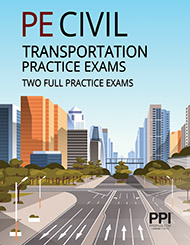PE Civil Transportation Practice Exams: Two Full Practice Exams
Available in Print or eTextbook
NEW 2025 edition updated to closed-book PE Civil Transportation format
Build exam day confidence and strengthen time-management skills with these two full 80-question practice exams.
The PE Civil Transportation Exams book delivers exactly what you need to practice for the PE Civil Transportation exam: two full 80-question practice exams, totaling 160 unique, exam-like problems. Our full, step-by-step solutions show you the most efficient problem-solving methods and, most importantly, require equations and tables from the official NCEES PE Civil Handbook and other closed-book design standards to solve.
We've meticulously studied the NCEES exam specifications to ensure the topic distribution and question difficulty accurately reflect what you'll face on exam day. Each problem is designed to be solved in an average of six minutes, helping you master the pace required for the 8-hour test.
- Realistic Exam-Like Questions: Two complete 80-question exams challenge you to solve problems under timed conditions, perfecting your time-management skills.
- Comprehensive Solutions: Our full, step-by-step solutions show you the most efficient problem-solving methods and, most importantly, require equations and tables in the official NCEES PE Civil Handbook and other closed-book design standards to solve.
- Exclusive Content: Gain an edge with 160 problems found exclusively in this book - these questions are not found in PPI’s online Learning Hub or online courses.
- Targeted Preparation: By matching the NCEES format and knowledge areas, you can confidently identify your strengths and weaknesses, allowing you to focus your study time effectively.
Topics covered:
- Project management
- Traffic engineering
- Roadside and cross-section design
- Horizontal design
- Vertical design
- Intersection geometry
- Traffic signals
- Traffic control design
- Geotechnical and pavement
- Drainage
Design standards referenced:
- AASHTO GDHS-7, A Policy on Geometric Design of Highways and Streets
- AASHTO GDPS-4-M, Guide for Design of Pavement Structures
- AASHTO GPF-1, Guide for the Planning, Design, and Operation of Pedestrian Facilities
- AASHTO HSM-1, Highway Safety Manual
- AASHTO MEPDG-2, Mechanistic-Empirical Pavement Design Guide: A Manual of Practice
- AASHTO RSDG-4, Roadside Design Guide
- FHWA HIF-12-026, Hydraulic Design of Highway Culverts
- HCM, Highway Capacity Manual
- MUTCD, Manual on Uniform Traffic Control Devices for Streets and Highways
eTextbook Benefits:
- One year of access
- Ability to download the entire eTextbook to multiple devices, so you can study even without internet access
- An auto sync feature across all your devices for a seamless experience on or offline
- Unique study tools such as highlighting in six different colors to tailor your study experience
- Features like read aloud for complete hands-free review
FAQs
Some states require a BS degree from an ABET-accredited engineering program to sit for the PE exam. Other states allow you to take the PE exam with a degree in engineering technology, physics, math, or chemistry—or without any degree—as long as you’ve met the required work experience. Check your state requirements to see if you can take the PE exam without an engineering degree.
Most states allow you to take the PE exam after passing your FE exam and gaining at least four years of post-college work experience. However, some states now allow examinees to sit for the PE exam before completing their work experience. Check your state requirements to see when you’re qualified to sit for the exam.
The PE exams are not considered easy to pass, but the exam will become easier if the content reflects topics that you're familiar with from your current line of work. Think about your career goals when considering the PE exam. Are you seeking a promotion in your current role? You should select the exam that best supports your current career. Are you trying to switch industries? Choose the exam that will set you up for success in your new field. Rather than seek out the easiest PE exam, select the one that will support your goals.
